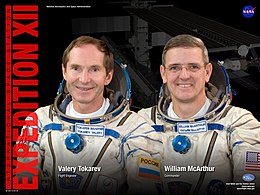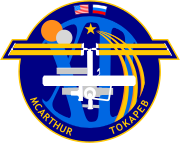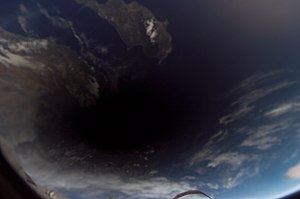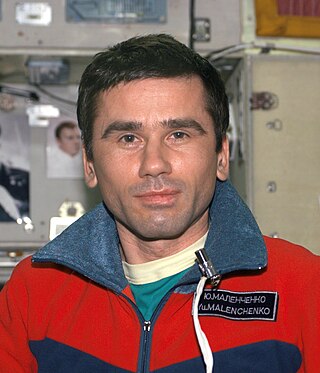
Yuri Ivanovich Malenchenko is a retired Russian cosmonaut. Malenchenko became the first person to marry in space, on 10 August 2003, when he married Ekaterina Dmitrieva, who was in Texas, while he was 240 miles (390 km) over New Zealand, on the International Space Station. As of December 2023, Malenchenko ranks third for career time in space due to his time on both Mir and the International Space Station (ISS). He is a former commander of the International Space Station.

Yury Valentinovich Lonchakov is a Russian former cosmonaut and a veteran of three space missions. He has spent 200 days in space and has conducted two spacewalks. From 2014 to 2017, Lonchakov served as head of the Yuri Gagarin Cosmonaut Training Center.
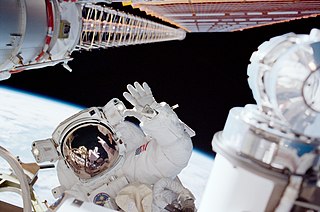
STS-97 was a Space Shuttle mission to the International Space Station (ISS) flown by Space Shuttle Endeavour. The crew installed the first set of solar arrays to the ISS, prepared a docking port for arrival of the Destiny Laboratory Module, and delivered supplies for the station's crew. It was the last human spaceflight of the 20th century.

Scott Joseph Kelly is an American engineer, retired astronaut, and naval aviator. A veteran of four space flights, Kelly commanded the International Space Station (ISS) on Expeditions 26, 45, and 46.
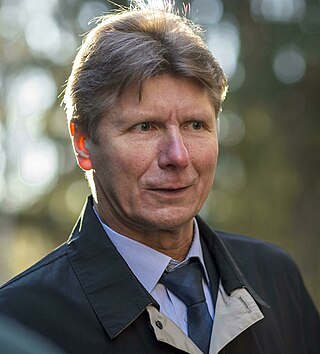
Gennady Ivanovich Padalka is a Russian Air Force officer and Roscosmos cosmonaut. Padalka held the world record for the most time spent in space at 878 days until Oleg Kononenko broke this record on February 4, 2024 at 07:30:08 UTC and is currently at 2nd position. He worked on both Mir and the International Space Station.

Valeri Ivanovich Tokarev is a Russian Air Force colonel and test cosmonaut at the Yuri A. Gagarin Cosmonaut Training Center. Tokarev traveled to space twice, and has performed two career spacewalks, before retiring in June 2008.

Mikhail Vladislavovich Tyurin is a former Russian cosmonaut who flew several missions to the International Space Station and completed four spacewalks during his career. He was awarded the title Hero of the Russian Federation for his work as a cosmonaut.

Fyodor Nikolayevich Yurchikhin is a Russian cosmonaut of Greek descent, engineer and RSC Energia test-pilot who has flown on five spaceflights. His first spaceflight was a 10-day Space Shuttle mission STS-112. His second was a long-duration stay aboard the International Space Station (ISS) as a flight engineer for Expedition 15; for this mission he was launched in the Soyuz TMA-10 spacecraft. He has undertaken two further long-duration stays aboard the ISS, as a crew member of Expedition 24 / 25. For this mission he was launched with the spacecraft Soyuz TMA-19, and he landed in November 2010, also with the Soyuz TMA-19 spacecraft. He served as Soyuz commander for his fourth mission aboard Soyuz TMA-09M, as flight engineer for Expedition 36 and ISS commander for Expedition 37. In April 2017, Yurchikhin launched on Soyuz MS-04 for the fifth spaceflight of his career, a six-month mission to the ISS as part of Expedition 51 and 52, for which he was the commander.

Pavel Vladimirovich Vinogradov is a former cosmonaut and commander of the International Space Station. He has flown into space three times, aboard Mir and the International Space Station, and was one of the top 10 astronauts in terms of total time in space after his third spaceflight. Vinogradov has also conducted seven spacewalks in his cosmonaut career, and holds the record for the oldest person to perform a spacewalk.
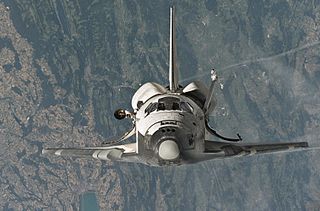
Expedition 11 (2005) was the 11th expedition to the International Space Station, using the Soyuz TMA-6, which stayed during the expedition for emergency evacuation.
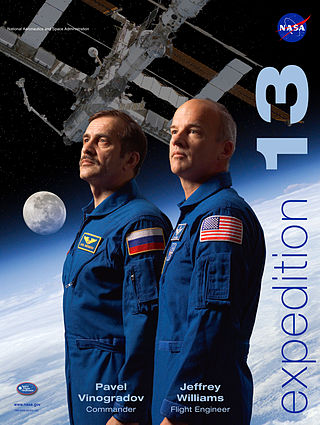
Expedition 13 was the 13th expedition to the International Space Station (ISS), and launched at 02:30 UTC on 30 March 2006. The expedition used the Soyuz TMA-8 spacecraft, which stayed at the station for the duration of the expedition for emergency evacuation.

Expedition 14 was the 14th expedition to the International Space Station (ISS). Commander Michael López-Alegría, and flight engineer Mikhail Tyurin launched from Baikonur Cosmodrome on 18 September 2006, 04:09 UTC, aboard Soyuz TMA-9. They joined Thomas Reiter, who had arrived at the ISS on 6 July 2006 aboard Space Shuttle Discovery during mission STS-121. In December 2006, Discovery mission STS-116 brought Sunita Williams to replace Reiter as the third member of Expedition 14. On 21 April 2007, López-Alegría and Tyurin returned to Earth aboard TMA-9. Landing occurred at 12:31:30 UTC.
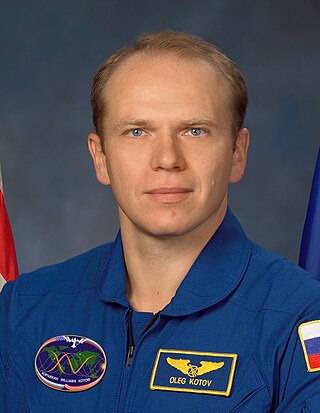
Oleg Valeriyevich Kotov was born on 27 October 1965 in Simferopol, Crimean oblast in the Ukrainian SSR. After a career as a physician assigned to the Soviet space program, he joined the Russian cosmonaut corps. He has flown three long duration spaceflights on the International Space Station logging over 526 days in space. Most recently, Kotov flew on the Soyuz TMA-10M/Expedition 37/Expedition 38 long duration spaceflight, from September 2013 until March 2014.

Expedition 15 was the 15th expedition to the International Space Station (ISS). Four crew members participated in the expedition, although for most of the expedition's duration only three were on the station at any one time. During Expedition 15, the ISS Integrated Truss Structure was expanded twice: STS-117 brought the S3/S4 truss, and STS-118 brought the S5 truss.

Akihiko Hoshide is a Japanese engineer, JAXA astronaut, and former commander of the International Space Station. On August 30, 2012, Hoshide became the third Japanese astronaut to walk in space.

Sergey Aleksandrovich Volkov is a retired Russian cosmonaut and engineer. He was a member of three missions to the International Space Station, spending more than a year in total in space. During his missions he did four spacewalks lasting more than 23 hours in total. Volkov retired from the Cosmonaut group in February 2017.
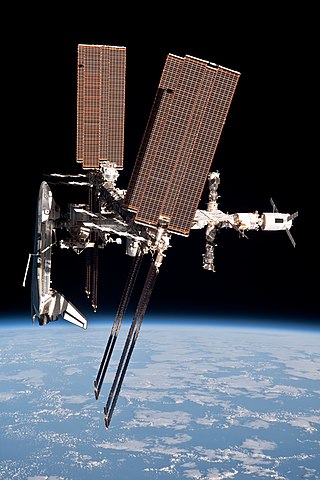
STS-134 was the penultimate mission of NASA's Space Shuttle program and the 25th and last spaceflight of Space ShuttleEndeavour. This flight delivered the Alpha Magnetic Spectrometer and an ExPRESS Logistics Carrier to the International Space Station. Mark Kelly served as the mission commander. STS-134 was expected to be the final Space Shuttle mission if STS-135 did not receive funding from Congress. However, in February 2011, NASA stated that STS-135 would fly "regardless" of the funding situation. STS-135, flown by Atlantis, took advantage of the processing for STS-335, the Launch on Need mission that would have been necessary if the STS-134 crew became stranded in orbit.

Oleg Ivanovich Skripochka is a Russian engineer and cosmonaut. In 2011 he was in space serving as an Expedition 25/26 crewmember.

Expedition 26 was the 26th long-duration mission to the International Space Station. The expedition's first three crew members – one US astronaut and two Russian cosmonauts – arrived at the station on board Soyuz TMA-01M on 10 October 2010. Expedition 26 officially began the following month on 26 November, when half of the crew of the previous mission, Expedition 25, returned to Earth on board Soyuz TMA-19. The rest of the Expedition 26 crew – one US astronaut, one Russian cosmonaut and one ESA astronaut – joined the trio already on board when their spacecraft, Soyuz TMA-20, docked with the station on 17 December 2010.

Aleksandr Mikhailovich Samokutyaev is a Russian politician and former cosmonaut. Samokutyaev served as a Flight Engineer for the International Space Station (ISS) long duration Expedition 27/28 missions. He also served as the Soyuz TMA-21 commander. He most recently served on the Soyuz TMA-14M Expedition 41/42 crew aboard the ISS. He was hired as a cosmonaut in the summer of 2003.
